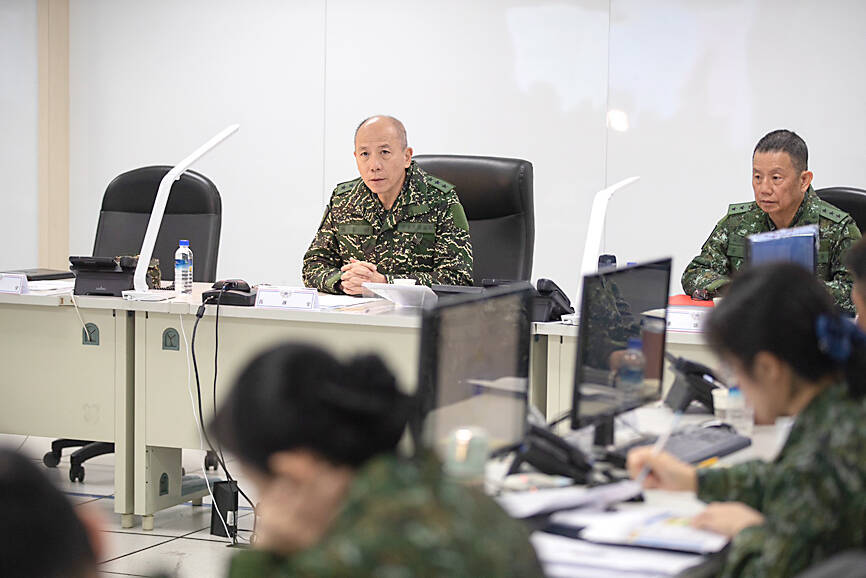This month’s annual Han Kuang military exercises are to feature six types of “gray zone” tactics used by the Chinese People’s Liberation Army (PLA) with the aim of weakening their effectiveness, Chief of the General Staff Admiral Mei Chia-shu (梅家樹) told the military yesterday.
The 41st Han Kuang drills, scheduled from Wednesday next week through July 18, would simulate a Chinese blockade and invasion, with President William Lai (賴清德) on Tuesday saying that Taiwan is already in a “war without gun smoke.”
In a speech broadcast to officers and soldiers yesterday, Mei said that the six types of harassment are: legal warfare, cognitive warfare, attrition, coercion, containment and provocation.

Photo courtesy of Military News Agency
The Chinese Communist Party (CCP) aims to use laws to challenge the international community’s ability to intervene in the Taiwan Strait, and uses cognitive and psychological warfare to spread misinformation and weaken the armed forces’ ability to respond, he said.
However, the army would continue to train, and maintain peace and stability in the Taiwan Strait, without being provoked or contained, Mei said.
This year’s Han Kuang exercises would mobilize the 22,000 reservists, feature new weaponry and run twice as long as previous iterations, the Ministry of National Defense said earlier this week.
The exercises would be divided into three parts: Simulating a PLA gray zone incursion that escalates into an invasion, practicing coastal combat and repelling an amphibious landing by the PLA, the ministry said.
The drills would include a live-fire portion, and feature a joint command structure and civil-military cooperation, it said.
They would also be combined with the Wanan air defense and Minan disaster prevention exercises to test air-raid, evacuation and urban resilience measures, the ministry said.
Taiwan’s increased focus on gray zone threats and its lengthening of the Han Kuang drills’ live-fire portion to 10 days have been praised by two US defense experts.
Ely Ratner, former US assistant secretary of defense for Indo-Pacific security affairs, wrote in an e-mail yesterday that the changes “reflect an important ongoing evolution in the strengthening of Taiwan’s defenses and resilience.”
“Taiwan is on the right track to contribute to deterrence,” Ratner said, adding that it should push forward with greater urgency.
John Dotson, director of the Washington-based Global Taiwan Institute, wrote in an e-mail that this year’s exercises would be much more meaningful.
They would be “less scripted,” allowing for “a bit more spontaneity, and the confusion that comes with actual warfare,” Dotson said.
In related news, 41 PLA aircraft and nine naval vessels were detected around Taiwan between 6am on Wednesday and 6am yesterday, the ministry said yesterday.
Thirty of the aircraft crossed the median line of the Taiwan Strait and entered Taiwan’s northern, central, southwestern and eastern air defense identification zones, it said.
Flight path charts from the ministry showed PLA aircraft routes that circled Taiwan.
The armed forces “monitored the situation and employed [patrol] aircraft, navy vessels and coastal missile systems in response to the detected activities,” the ministry said.

Beijing could eventually see a full amphibious invasion of Taiwan as the only "prudent" way to bring about unification, the US Department of Defense said in a newly released annual report to Congress. The Pentagon's "Annual Report to Congress: Military and Security Developments Involving the People's Republic of China 2025," was in many ways similar to last year’s report but reorganized the analysis of the options China has to take over Taiwan. Generally, according to the report, Chinese leaders view the People's Liberation Army's (PLA) capabilities for a Taiwan campaign as improving, but they remain uncertain about its readiness to successfully seize

Taiwan is getting a day off on Christmas for the first time in 25 years. The change comes after opposition parties passed a law earlier this year to add or restore five public holidays, including Constitution Day, which falls on today, Dec. 25. The day marks the 1947 adoption of the constitution of the Republic of China, as the government in Taipei is formally known. Back then the Chinese Nationalist Party (KMT) governed China from Nanjing. When the KMT, now an opposition party in Taiwan, passed the legislation on holidays, it said that they would help “commemorate the history of national development.” That

Taiwan has overtaken South Korea this year in per capita income for the first time in 23 years, IMF data showed. Per capita income is a nation’s GDP divided by the total population, used to compare average wealth levels across countries. Taiwan also beat Japan this year on per capita income, after surpassing it for the first time last year, US magazine Newsweek reported yesterday. Across Asia, Taiwan ranked fourth for per capita income at US$37,827 this year due to sustained economic growth, the report said. In the top three spots were Singapore, Macau and Hong Kong, it said. South

Snow fell on Yushan (Jade Mountain, 玉山) yesterday morning as a continental cold air mass sent temperatures below freezing on Taiwan’s tallest peak, the Central Weather Administration (CWA) said. Snowflakes were seen on Yushan’s north peak from 6:28am to 6:38am, but they did not fully cover the ground and no accumulation was recorded, the CWA said. As of 7:42am, the lowest temperature recorded across Taiwan was minus-5.5°C at Yushan’s Fengkou observatory and minus-4.7°C at the Yushan observatory, CWA data showed. On Hehuanshan (合歡山) in Nantou County, a low of 1.3°C was recorded at 6:39pm, when ice pellets fell at Songsyue Lodge (松雪樓), a